Heliogabalus' religion (1)
Heliogabalus: emperor of Rome, ruled from 218 to 222, famous for his religious reforms and the introduction of the cult of the Syrian sun god Elagabal.
Religious policy (part 1)
Chronology
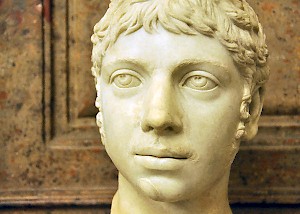
As the written sources offer a poor chronological framework, scholars have used coins and inscriptions to create a chronology. The first coins of Heliogabalus' reign hardly portray Sol Invictus Elagabal. Only four coins dating from around 220 depict the god.
The written sources do not contradict the conclusion that the cultic reforms took place in 220. During Heliogabalus' long absence from Rome at the beginning of his reign, he had only given instructions that the god Sol Invictus Elagabal should be included in prayers and mentioned during sacrifices. According to Herodian, it was after Heliogabalus' arrival in Rome (in the late summer of 219) that he introduced his god and the other religious reforms.
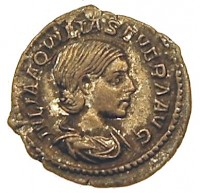
In short: during the first year-and-a-half of Heliogabalus' reign, the god was hardly propagated. It is only in 220 that a break can be seen with the old policy. Heliogabalus showed his independence and free will. Early in the same year, he married Julia Aquilia Severa.
The Elagabalium
A temple was built to Sol Invictus and many altars were built around it. The new shrine was dedicated to the god in c.220/221. It stood on the Palatine and was enormous. The terrace had already been constructed by the emperor Domitian (81-96) and may originally have been dedicated to Jupiter. Heliogabalus now enlarged the terrace and devoted a temple to Sol Invictus Elagabal. After his death, the temple was rededicated to Jupiter by Severus Alexander. Today only the terrace and the foundations of the temple remain.
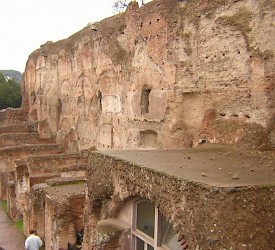
The author of the Historia Augusta accuses Heliogabalus of depriving the other gods of their status by making Elagabal the most important god.note One god was chamberlain to the supreme god, the other a slave. The emperor wished that every form of worship was included in the cult of Heliogabalus. According to Cassius Dio, Heliogabalus placed Sol Invictus Elagabal above Jupiter in all aspects of daily life and he presented himself as this new god's high priest. The cult was to take place on the Palatine near the imperial palace. None of this forces us to assume that Heliogabalus had already placed his god above Jupiter before 220.
Another question is when Heliogabalus accepted the title of sacerdos amplissimus dei Solis Invicti Elagabali. It held more authority than pontifex maximus and on coins, it was placed before the abbreviation p.m. After careful research of several coins, scholars tend to date Heliogabalus' priestly title between 220 and 222. Perhaps a more precise date can be given when one studies Heliogabalus' image. The coins show us four stages:
- a boy's portrait;
- a boy with slightly longer sideburns
- sideburns up to the chin and a hardly recognizable mustache
- emperor with a full beard.
The latter usually portrays the emperor as priest. Only two images of the young boy carry the title of sacerdos amplissimus at the back. The coins of the full bearded emperor are usually dated in 221.
The author of the Historia Augusta reports that after building the temple, Heliogabalus moved the emblems of the Great Mother, the fire of Vesta, the palladium (a statue of Minerva), the shields of the Salii and other sacred objects to the new sanctuary.note These were considered to be severe acts of sacrilege. For instance, the statue of Minerva had been hidden from sight and was not to be moved from its place in the temple of Vesta, yet Heliogabalus had entered the holy shrine, had touched the statue, and ordered its removal. He soon gave up the palladium under the pretense that his god was displeased with Minerva.
Instead, the celestial Juno (Tanit) was ordered to come from Carthage. She was to marry Sol Invictus Elagabal. Dio also mentions this divine marriage, which he calls an absurdity.note The author of the Historia Augusta remarks that Heliogabalus was initiated in the rites of the Great Mother and took part in the taurobolium-rites in order to steal her holy objects as well.note
The festival of Sol Invictus Elagabal
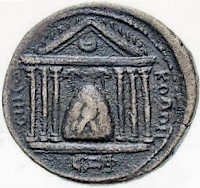
The intensity of the cult cannot be known because of lack of evidence. We know, however, about a college of priests that stood under Heliogabalus' personal authority. Thanks to Herodian, we also know about the main festival of Sol Invictus Elagabal, which took place each year in mid-summer. The festival consisted of sacrifices to the god and festivities for the people. The baetyl was carried in a chariot bestowed with gold, silver and precious gems. The chariot was drawn by six magnificent white horses also clad in gold and beautiful ornaments. The emperor walked in front of the chariot, holding the bridles of the horses and his eyes fixed on the cult image. He walked all the way to a temple that lay in an outlying district of the city near the old temple of Hope. The other images of the gods in Rome were carried along in the procession as well as precious temple dedications and imperial standards. The cavalry joined the procession and bodyguards flanked the emperor. After the necessary sacrifices the emperor bestowed precious items upon the people. (This liberalitas is recorded for both 220 and 221.) On the next day, the gods were brought back to the Palatine. The resemblance to the Akitu festival from ancient Babylon, although now redefined as cult of Sol Invictus Elagabal, is evident.
High Priest of Sol Invictus Elagabal
As high priest of the Sol Invictus cult Heliogabalus performed his ecstatic rites. Every morning he would appear in public, clad in his expensive Syrian robes and jewelry. (If we are believe our written sources, he was the first and only Roman emperor to dress in robes of pure, Chinese silk.) Accompanied by dancing women and music produced on flutes and drums, he performed the sacrifices to his god with the help of a college of priests under his rule.
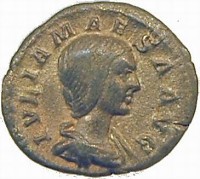
His grandmother, Julia Maesa, was already deeply concerned with this behavior and tried to persuade her grandson to wear Roman clothing. This he refused. Cassius Dio calls his clothing barbaric and records the emperor's nickname "the Assyrian".note The Roman populace, on the other hand, may not have found his appearance as startling as Julia Maesa feared, considering that Heliogabalus had sent an image of himself before his arrival. Besides, many Romans already worshipped oriental gods.
During the rituals, the Senate and equestrian order - people with a very traditional outlook - were obliged to be present. The entrails and spices were carried by military prefects and important officials who were clad in Phoenician style as well. Heliogabalus believed he honored these men by granting them this privilege, but it is likely that they had some mental reservations. Conservatives who mocked the emperor and disapproved of his way of life, were executed.
Several things were required of the high priest of Sol Invictus Elagabal, because Dio speaks of the emperor's circumcision and his abstinence from pork.note The historian also says that Heliogabalus had made plans to cut off his genitals altogether, but Dio does not believe that this had to do with the emperor's religion. Instead, he presents it as evidence of Heliogabalus' effeminacy. The circumcision, however, was carried out on other followers as well. All other facets of this religion were barbaric in Dio's eyes. The chanting, the innumerable amulets, animals that were kept either in the palace or in the temple, child sacrifice: Dio's catalogue of horrors is endless.note
Dio exaggerates. Jews and Egyptians also circumcised their boys and abstained from pork, and the Romans had no difficulties with these customs. The fault Dio finds in Heliogabalus is that he was an emperor and had to represent everything that the Roman people stood for. In order to stand at the top of the nation, an emperor was expected to set a good example in Roman virtues. Circumcision and abstaining from pork did not belong on this list. Dio was a senator, a conservative, and an elitarian.
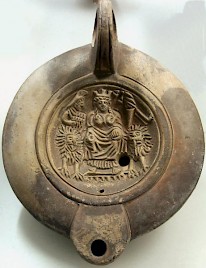
Heliogabalus' self-castration was not uncommon too. In Hierapolis, the Syrians venerated another triad of gods: the weather god Hadad, his wife Atargatis and one Semeion. Atargatis was the most outstanding of the three and very popular in Syria. She resembles the Phrygian goddess Cybele: she was a fertility goddess, mother of the gods and mother of the city. Like Elagabal, Cybele was also worshipped as a baetyl. Cybele is known to have had her own castrated priests named galloi. As Cybele and Atargatis are twins, it is not unlikely that castration was part of the Atargatis cult as well.
According to Lucian's The Syrian goddess, Atargatis had a temple where fish and wild animals were kept. This corresponds with the zoo in Rome mentioned by Cassius Dio and the author of the Historia Augusta. Wild animals, moreover, are a typical attribute of Cybele.
The Syrian Atargatis cult explains the prostitution and castration that are mentioned as aspects of the cultic reforms of Heliogabalus. They were acts of purification or fertility - blood and sperm to renew the earth. On the other hand, it is unlikely that Heliogabalus actually castrated himself. If he would have had these plans, many subjects would have tried to persuade him not to carry them out.
Heliogabalus is also accused of child sacrifice. This charge has been noted in Cassius Dionote and in the Historia Augusta.note It is a lot more serious than the other charges. The author of the Historia Augusta says that the emperor chose beautiful, noble, young boys for these sacrifices, whose parents were still alive - all this in order to inflict more sadness and mourning. The sacrifices were carried out by magicians who studied the entrails afterwards.
Few scholars have been willing to accept this charge, which portrays Heliogabalus as a true monster. They see this information as another attempt to discredit the emperor and Semitic culture. It was a stereotypical accusation which was also thrown at Jews, Christians and Isis devotees. And in fact, the way the child sacrifice is described by Dio, including the inspection of the entrails, looks more like an old Etruscan tradition than a Semitic cult act.
However, human sacrifice did occur in Phoenician cults and was perhaps also known and practiced in Emesa. Child sacrifice has been attested for in the Bible and was practiced by the Canaanites; its existence is also suggested by many sarcophagi and stelae in Carthage. Although child sacrifice was forbidden in Tyre after the conquests of Alexander the Great, it was still practiced in Carthage in the second century BCE. It cannot be excluded that this practice also continued to be performed in Emesa. On the other hand, the charge is stereotypical, and perhaps not incomparable to charges against modern catholics about the Inquisition and the trial of Galilei - outdated, hardly relevant, partly incorrect, and the stuff of which propaganda is made.